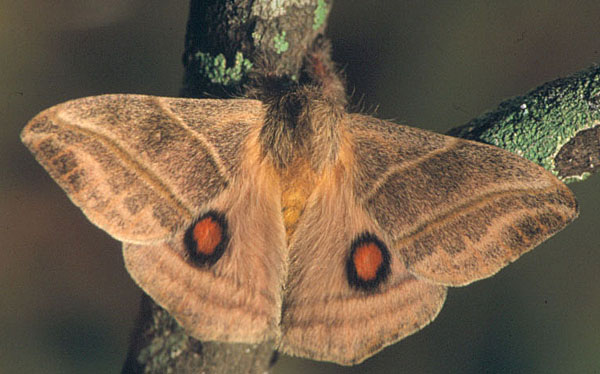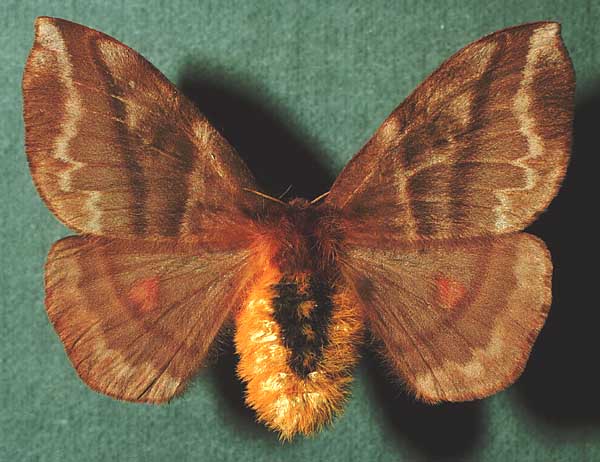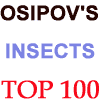Hylesia lineata
|
|
Updated as per Heppner's Checklist: Part 4B 1996, December 26, 2005
Updated as per Lemaire's Hemileucinae 2002, December 26, 2005
Updated as per
http://www.inbio.ac.cr/bims/k02/p05/c029/o0119/f00885.htm IB, April 2008
Updated as per personal communication with Robert Lehman (La Ceiba, Atlantida, Honduras, 120m, February); December 2009
Updated as per CSIRO PUBLISHING: Invertebrate Systematics, 2012, 26, 478–505
http://dx.doi.org/10.1071/IS12038:
"What happens to the traditional taxonomy when a wellknown tropical saturniid moth fauna is DNA barcoded?; Dan Janzen, et.al.;
Received 8 May 2012, accepted 22 September 2012, published online 19 December 2012; April 23, 2013
|
Hylesia lineata
hye-LEES-ee-uhMlih-nee-AY-tuh
Druce, 1884

Hylesia lineata moth courtesy of Leroy Simon.
This site has been created by
Bill Oehlke at oehlkew@pei.sympatico.ca
Comments, suggestions and/or additional information are welcomed by Bill.
TAXONOMY:
Superfamily: Bombycoidea, Latreille, 1802
Family: Saturniidae, Boisduval, [1837] 1834
Subfamily: Hemileucinae, Grote & Robinson, 1866
Tribe: Hemileucini, Grote & Robinson, 1866
Genus: Hylesia, Hubner, [1820]
|
MIDI MUSIC
"Someone to Watch Over Me"
copyright C. Odenkirk
MIDI CITY
ON.OFF
<bgsound src="watch.mid" LOOP=FOREVER>
|
DISTRIBUTION:
Hylesia lineata
(wingspan: males: 38-44mm; females: 45-61mm) flies in
Mexico: San Luis Potosi, Puebla, Jalisco,
Oaxaca, Chiapas, Quintana Roo;
Belize: Cayo;
Guatemala:
Zacapa,
Huehuetenango,
El Peten;
Honduras: Cortes, Atlantida (RL);
El Salvador: Ahuachapan;
Nicaragua: ;
Costa Rica: Guanacaste, San Jose,
Cartago, Puntarenas (CL), Alajuela (IB); and
Panama: Chiriqui.
Dan Janzen reports this moth as a dry forest species in Guanacaste, Costa Rica.
HABITAT:
This species flies in deciduous forests, and it has been recorded from sea level to 2000m.

Hylesia lineata male, La Ceiba, Atlantida, Honduras,
38mm, February 9, 2008, 120m, courtesy of Robert Lehman, id by Bill Oehlke.
Hylesia lineata and Hylesia subaurea are quite similar. Both fly in Honduras. I have gone with H. lineata for the above specimen
due to size (38mm) and elevation (120m). Hylesia subaurea tend to be larger (males 41-46mm) and fly at elevations from 1300-1650m.
FLIGHT TIMES AND PREFERRED FOOD PLANTS:
This species appears to be bivoltine in Costa Rica with diapause in
the egg stage during the dry season (November-early May). Adults
have been taken in November and July.
Robert Lehman reports a February flight in Honduras.
Hylesis lineata
larvae feed at night on a great variety of trees.

Hylesia lineata female
courtesy of Dan Janzen.
ECLOSION, SCENTING AND MATING:
Females extend a scent
gland from the tip of the abdomen. Males use highly developed
antennae to track the airbourne pheromone to locate
the females.
OVA, LARVAE, COCOONS, AND PUPAE:
Eggs are
deposited in layers in one large, hair-covered cluster. Larvae are
highly gregarious.This cluster of first instar larvae is not unusual. In the second instar larvae
have black heads and orangey-yellow spines on a green body. | 
|
Urticating spines offer the Hylesia lineata larvae
much protection, and stinging caterpillars must be handled with great care.Photo courtesy of Leroy Simon. |  |
There is considerable change in body colouration as the larvae develop. Larvae of this
genus spin cocoons.Photo courtesy of Dan Janzen. |  |
Listed below are the primary and alternate food plants listed in
Stephen E. Stone's Foodplants of World Saturniidae. It is
hoped that this alphabetical listing followed by the common name of
the foodplant will prove useful. The list is not exhaustive.
Experimenting with closely related foodplants is worthwhile.
Acacia baileyana
Acacia tenuifolia
Allophyllus occidentalis
Banisteriopsis muricata
Bauhinia ungulata
Bombacopsis quinatum
Byrsonima crassifoila
Byttneria aculeata
B. catalpaefolia
Calliandra emarginata
Calycophyllum candidissimum........
Caseara arguta
Caseara sylvestris
Cassia biflora
Chomelia spinosa
Cordia alliodora
Cordia corymbosa
Cupania guatemalensis
Dalbergia retusa
Diphysa robiniodes
Enterolobium cyclocarpum
Erythroxylum havanense
Glericidia sepium
Gouania polygama
Guazuma ulmifolia
Guettarda macrosperma
Hirtella racemosa
Hymenaea courbaril
Hyptis pectinata
Inga vera
Lantana camara
Lonchocarpus minimiflorus
L. costaricensis
Luehea speciosa
Lysiloma auritum
Machaerium kegelii
Malvaviscus arboreus
Mimosa pigra
Muntingia calabura
Myrospermum frutescens
Ouratea lucens
Paullinia cururu
Persea americana
Pithecellobium lanceolatum......
Psidium guineense
Robinia pseudoacacia
Stigmaphyllon elliticum
Serjania schiedeana
Tabebuia rosea
Urvillea ulmacea
Xanthoxylum seulosum
Zuelania guidonia
| Bailey's acacia
Acacia
Palo blanco
Banisteriopsis muricata
Bauhinia ungulata
Bombacopsis quinatum
Nanche
Tezak/Zarza
Tezak/Zarza
Powder puff
Degame
Caseara arguta
Caseara sylvestris
Cassia
Chomelia spinosa
Apacahuite /Trompillo
Cordia
Sacpom/Grande betty
Dalbergia retusa
Diphysa robiniodes
Orejon/Elephant's ear
Coca
Nicarauan cocoa-shade
Jaboncillo
Guacima/Bay cedar
Guettarda macrosperma
pigeonplum
West Indian locust
Hyptis pectinata
Inga vera
Yellow sage
Cabbagebark
Cabbagebark
Luehea speciosa
Quiebracha
Machaerium kegelii
Wax mallow
Zarza
Jamaica cherry/Strawberry tree
Myrospermum frutescens
Ouratea lucens
Guarana
Avocado
Blackbead
Guava
Black locust/False acacia
Stigmaphyllon elliticum
Serjania schiedeana
Palo de rosa
Apaac
Prickly ash
Tamay
|
Use your browser "Back" button to return to the previous page.
Return to Hylesia Index
Goto Mexico and Central American Saturniidae Directory
Goto South American Saturniidae Directory
Goto Main Saturniidae Index
The pronunciation of scientific names is
troublesome for many. The "suggestion" at the top of the page is
merely a suggestion. It is based on commonly
accepted English pronunciation of Greek names and/or some
fairly well accepted "rules" for latinized scientific names.
The suggested pronunciations, on this page and on other pages,
are primarily put forward to assist those who hear with internal
ears as they read.
There are many collectors from different countries whose
intonations and accents would be different.
I do not know the origin of the genus name
Hylesia.
The species name "lineata" probably refers to the distinct line
markings on the forewings.

| 
Support this website and visit other insect sites by
clicking flashing butterfly links to left or right.
|

|
Use your browser "Back" button to return to the previous page.







